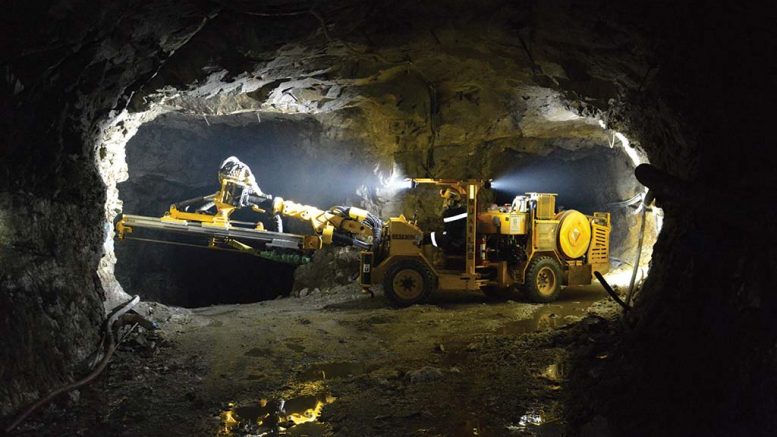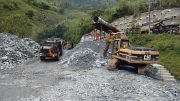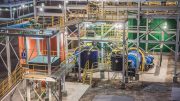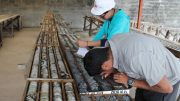For mineral explorers and developers, the northern Andean countries of Colombia, Ecuador and Peru are a potent combination of richly endowed metal mineralization and under-explored terrain, all hosted in relatively mining-friendly jurisdictions. Here’s a look at eight juniors with active programs in the area.
GRAN COLOMBIA GOLD
What company is the biggest gold and silver producer in Colombia? It’s Colombia-focused, Toronto-based Gran Colombia Gold (TSX: GCM; US-OTC: TPRFF), with several underground mines and two processing plants at its Segovia and Marmato operations.

Map of Gran Colombia Gold’s operations in Colombia. Credit: Gran Colombia Gold.
Gran Colombia is currently in the midst of an expansion and modernization project at its flagship high-grade Segovia Operations in Antioquia Department, which produced 148,649 oz. gold in 2017, up 18% from 2016.
At Marmato in Caldas Department, Gran Colombia produced 25,162 oz. gold in 2017, up 7% from 2016. In October, the company announced it would change focus at Marmato from open-pit mining to underground operations.
In total for 2017, Gran Colombia produced a guidance-beating 173,821 oz. gold from both operations, up 16% from 2016.
In January 2018 alone, Gran Colombia produced a total of 16,700 oz. gold with Segovia contributing 14,613 oz. and Marmato chipping in another 2,087 oz. gold, which would translate to an annualized rate of 200,000 oz. gold.
In February, Gran Colombia laid out terms for a proposed US$152-million debt financing, with GMP Capital and UBS Securities serving as lead agents.
Serafino Iacono, executive co-chairman of Gran Colombia, explains the rationale for the financing: “We believe the dilution overhang from our convertible debentures, as many investors have communicated to us, is having an adverse impact on our share price relative to comparable valuations for our peers. For this reason, in light of the current market conditions, we are proceeding with the offering to allow the company to simplify its capital structure, having just one long-term debt instrument, and to enhance shareholder value by capping the potential dilution to existing shareholders through exercise of the new warrants at 18.8 million additional common shares compared with a range of 18.7 million to 72.1 million additional common shares under the current convertible debentures.”
EQUINOX GOLD

The Koricancha mill is a fully-operational industrial gold milling facility located in Southern Peru. Credit: JDL Gold.
Ross Beaty-linked Equinox Gold (TSXV: EQX) will be producing from its Aurizona gold mine in Brazil later this year and is advancing its past-producing Castle Mountain gold mine project in California, but the Vancouver-based junior also has a suite of less prominent gold and copper assets across the Americas, including in Peru and Ecuador.
In southern Peru’s coastal region, Equinox operates its 83%-owned, 350-tonne-per-day Koricancha gold toll mill. Gold production restarted at the end of 2016 and is ramping up towards capacity, with the potential to produce 50,000 to 75,000 oz. gold annually. Ore is bought from local artisanal miners.
In southeast Ecuador, Equinox has its wholly owned Warintza porphyry copper-molybdenum project, where it has drilled 13 holes totalling 6,500 metres. Equinox says it “hopes to resume exploration” at Warintza in 2018. According to a 2012 resource estimate, Warintza has a 195-million-tonne resource grading 0.42% copper and 0.031% molybdenum, for contained metal of 2.1 million lb. copper and 132 million lb. molybdenum.
PANORO MINERALS

Panoro Minerals’ Antilla copper-molybdenum project, 140 km southwest of Cuzco in southern Peru. Credit: Panoro Minerals.
Vancouver-based Panoro Minerals (TSXV: PML; US-OTC: POROF) continues to makes strides advancing its flagship Cotabambas copper project in southern Peru, where it has completed 80,000 metres of drilling since 2007.
Panoro’s drilling program is underway at the Maria Jose and Petra-David targets at Cluster 1, with 5,000 metres expected by April. The drilling will expand into the Chaupec skarn target in Cluster 2 in August, with 5,000 metres budgeted by the end of 2018.
Indicated resources at Cotabambas stand at 117.1 million tonnes grading 0.42% copper, 0.23 gram gold per tonne and 2.74 grams silver per tonne, while inferred resources are 605 million tonnes at 0.31% copper, 0.17 gram gold and 2.33 grams silver.
SIERRA METALS

Surface facilities at Sierra Metals’ Yauricocha polymetallic mine in Yauyos province, Peru. Photo by The Northern Miner.
Sierra Metals (TSX: SMT; NYSE-AM: SMTS) owns and operates three precious and base metal mines in Latin America: the 82%-owned Yauricocha mine in Peru and the Bolivar and Cusi mines in Mexico.
Located in Lima Department, the Yauricocha mine produces silver, lead, zinc, copper and gold from a high-temperature, carbonate-replacement deposit. It’s an underground mine with miners using sublevel caving and cut-and-fill methods, with ore processing in a flotation plant.
In February, Sierra reported that a drill hole at the Yauricocha mine intersected 99 metres grading 1.48% copper, 12 grams silver per tonne, 0.05% zinc, 0.01% lead and 0.7 gram gold per tonne, and that new drilling in the Cuye zone confirms wide, high-grade extensions at the mine.
Sierra Metals said that “mineralized areas noted in core continue to identify large dioritic intrusive inclusions, which previously were never studied, and are the widest intercepts of copper mineralization in Sierra Metals’ history. This suggests a new geological interpretation concept in the intrusive rocks, with potentially larger dimensions.”
SOLGOLD

Benn Whistler, SolGold’s technical services manager, holds a core tray at SolGold’s Cascabel copper-gold project in Ecuador. Credit: SolGold.
SolGold’s (TSX: SOLG; LON: SOLG; US-OTC: SLGGF) Cascabel property in northeastern Ecuador is one of the world’s most exciting grassroots exploration projects, and the company continues to grow the footprint of the world-class Alpala copper-gold deposit and neighbouring targets, Alpala Northwest, Hematite Hill and Alpala Southeast.
In January, SolGold tabled an astonishing maiden resource for Cascabel of 430 million indicated tonnes grading 0.52% copper and 0.43 gram gold per tonne, plus 650 million inferred tonnes grading 0.45% copper and 0.30 gram gold.
SolGold says it has drilled the deepest-ever hole using a man-portable rig, at 2,217 metres, and the company has drilled over 80,000 metres to date.
Its best hole so far at Cascabel is hole 12, which returned 1,560 metres grading 0.59% copper and 0.54 gram gold per tonne.
At last count, SolGold had US$90 million in cash.
TAHOE RESOURCES

Photo from 2014 of the Shahuindo project in Cajabamba, Peru. Credit: Sulliden Gold
Tahoe Resources (TSX: THO; NYSE: TAHO) has grown from a single-asset miner with its Escobal silver mine in Guatemala to also acquiring and developing the La Arena and Shahuindo gold mines in Peru and the Timmins West and Bell Creek gold mines in Ontario.
Shahuindo is an open-pit, heap-leach gold mine in northern Peru, 30 away from La Arena, that reached commercial production in May 2016 at a capacity of 10,000 tonnes per day. But Tahoe is expanding this to 36,000 tonnes per day by mid-2018, with ramping up to occur in the second half of the year.
As of January, proven and probable oxide reserves stood at 127.8 million tonnes grading 0.46 gram gold per tonne, or 1.9 million oz. gold, while measured and indicated oxide resources totalled 156.7 million tonnes at 0.45 gram gold for 2.28 million oz. gold.
La Arena is also an open-pit, heap-leach gold mine, exploiting a high-sulphidation, epithermal oxide gold deposit hosted in brecciated sandstone. Oxide reserves there stand at 44 million tonnes at 0.40 gram gold, while measured and indicated oxide resources are 50 million tonnes at 0.40 gram gold. The mine produced 204,400 oz. gold in doré in 2016.
TOACHI MINING

Personnel at Toachi Mining’s La Plata gold property in Ecuador. Credit: Toachi Mining.
Toronto-based and Jonathan Goodman-led Toachi Mining (TSXV: TIM; US-OTC: TIMGF) describes its La Plata property in north-central Ecuador as hosting a gold-rich, volcanogenic massive sulphide deposit that was the subject of small-scale mining from 1975–1981 by Finnish giant Outokumpu. Toachi says the project benefits from a modern drill and exploration database, which was completed by Cambior from 1996–1999 and Cornerstone Capital from 2006–2009. Its drilling program so far covers 14,500 metres.
At a 4 gram gold equivalent cut-off grade, the Plata deposit hosts an inferred resource of 1.9 million tonnes at 4.1 grams gold per tonne, 49.4 grams silver per tonne, 3.3% copper, 0.6% lead and 4.5% zinc.
Other poeple involved in the company include chairman Laurence Curtis and directors Peter Nixon, Ebe Scherkus and Carolina Vargas.
AURANIA RESOURCES

Workers in the field at Aurania Resources’ Lost Cities-Cutucu gold property in Ecuador. Credit: Aurania Resources.
Toronto-based Aurania Resources (TSXV: ARU; US-OTC: AUIAF) is exploring for gold at its Lost Cities project in southeastern Ecuador in the Cordillera del Cutucu region, which is contiguous with the Cordillera del Condor. The Cutucu forms part of the Northern Andean Jurassic metallogenic belt, which contains clusters of porphyry copper, gold-copper skarn and epithermal gold deposits.
In its most recent technical update, Aurania’s founder and CEO Keith Barron says the project’s Latorre area is “developing into a large and growing target for epithermal gold-silver. We are seeing characteristics that are not only similar to those that led to the discovery of the Fruta del Norte gold-silver deposit, 110 km south, but also to the Alto Chicama deposit (Lagunas Norte mine) in northern Peru. The identification of numerous diatreme breccias in the Latorre area is reminiscent of those that host a large part of the gold-silver endowment at Alto Chicama.”
Aurania’s plan is to advance work on the Latorre target area, while the rest of its staff carries out stream-sediment sampling.






Gran Colombia is a disaster of a company,which has disappointed shareholders , managed by doggy people.Management all the way to the top,have no respect for shareholders as equity ownership.They keep good relationships with financial& buy side brokers. Before you invest,have a look at there mine-site.Absolute disaster! They think there funds are better than yours.